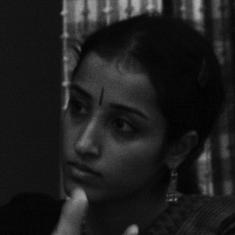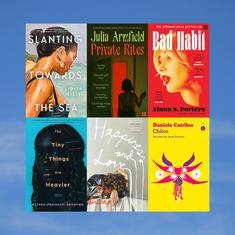In an illustration by artist Agrima Kaji, a young woman can be seen holding her head high. Her pose, deftly detailed by the artist, radiates confidence and ease. She has wind in her hair and intricate tattoos on her body.
The illustration is among the 31 Kaji drew for her Beauty in Diversity project. Each features the profile of a woman dressed in traditional attire and depicts specific cultural identifiers associated with different Indian states. The images, shared on Kaji’s Instagram, are evocative and endearing celebrations of India’s cultural and ethnic diversity. But they also hint at the complexity of social and cultural mechanisms, which define collective identity.
Beauty in Diversity began with Kaji’s questions about her own identity. “My grandfather is from Himachal Pradesh, my mother is from Uttarakhand and my grandmother from Punjab,” said Kaji, who lives in Hyderabad. “And I am married into a Gujarati family. I have very diverse roots and I have always wondered what identity I should put forth as my own.”
Any attempt by Kaji “to define” herself became more difficult every time she moved cities. “I went from being a Delhiite to a Bangalorean and then a Hyderabadi,” said the 28-year-old, who is an alumna of the Delhi School of Art and National Institute of Design. Beauty in Diversity, then, was a means for Kaji “to find my own identity”.
Kaji’s illustrations highlight cultural practices, dances and rituals. Maharashtra, for instance, is represented by a woman performing lavani, Tamil Nadu by a woman striking a powerful Bharatanatyam pose, and Andhra by a Kuchipudi dancer. The illustration inspired by Bihar features a woman performing Chhath puja, a four-day Hindu festival dedicated to the sun. Meanwhile, Telangana is represented by a Hyderabadi woman wearing a hijab.
Kaji’s images feature a curious blend of minimalist lines and meticulous detail. While some emphasise the posture of the woman, others highlight the design on the fabric of her garment. The aesthetic of each image is determined by the story that Kaji hopes to tell with it. In her illustration for Bihar, she wanted to “highlight the significance of Chhath Puja, why it is done, and also the textile of the state”. So she tried to bring out “the serenity of the sea, the peaceful environment of worship, and also the Madhubani art on the saree”.
The aesthetic of the Beauty in Diversity series is inspired by Danish artist Pernille Orum and Disney’s princesses. While the facial structure and body language of the women remind of Oerum’s designs, the air of innocence and wide-eyed wonder around Kaji’s characters is reminiscent of Disney characters. “They [the Disney princesses] have inspired me since childhood,” Kaji said. “I wanted to bring that association to India, to hint that we are all princesses, and we need to start acknowledging our stories.”
Kaji’s decision to depict women representing their cultural identity is particularly loaded, since women’s bodies are habitually burdened with the task of portraying tradition and nationhood. But the artist hopes that her illustrations will enable women to own their narratives. “We, as women, have so many stories to tell. We have different shades of power. I feel that we need to realise and see these aspects of our lives. I want to empower women to see the power that they hold.”
She began her series in July 2018 when she was reading about the local textiles of Jammu and Kashmir. Her first illustration, which featured a pheran-clad woman, drew such an encouraging response that she broadened her research. “Initially, I just started with the idea of costumes. But [upon] hearing from the people of each state that I represented [with the illustration], I got to know that there is so much more that cannot be left unacknowledged.”
These interactions also helped the artist to identify communities that are underrepresented. “I started seeing that there are so many tribes and cultures, who need that recognition and appreciation.” To redress this in a small way, she included images of women from the Wancho tribe of Arunachal Pradesh, Angamis of Nagaland and Baigas of Madhya Pradesh. Kaji concluded the series on February 17. All 29 Indian states as well as New Delhi have been represented. The series also includes an illustration that celebrates the decriminalisation of Section 377 of the Indian Penal Code.
Faces are inextricably associated with identity, but Kaji made a strategic decision to avoid dwelling on the facial features of her women. “I try to make it [the face] as generic as possible, because people have certain preconceived notions associated with how people look,” she said. “I wanted to highlight the narrative of different cultures [and] their stories, more than their appearance.” Her focus is more on textiles and history, “rather than how people of certain communities look”.
By depicting a singular facet of each state, the series also points to the ways in which one marker of identity often dominates over others. Even as she chooses to highlight one aspect of each state, Kaji is conscious that there are several factors that go into the creation of a state’s identity. “The biggest thing I learned from the series was that there is so much still left to learn about each state.”
Kaji reached a paradoxical revelation during her work. “In order to celebrate our own individuality, we have to acknowledge all the stories we have in the country. Everyone has their own story, and it should be uniquely celebrated.” She hopes that the Beauty in Diversity series will make people feel represented and acknowledged. “I want people…to be able to identify with my illustrations. I often get messages from people who feel happy that their state has been represented in some way…That’s all I want.”











